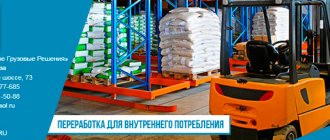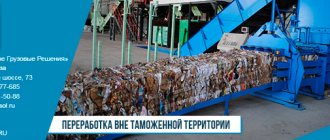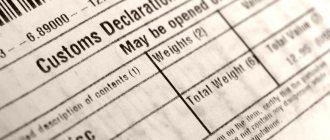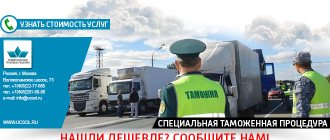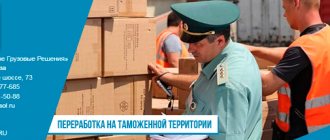HomeCustoms clearanceCustoms proceduresTemporary importation
Temporary import (admission) is a customs procedure (previously the customs regime - temporary import, as amended by the Customs Code of the Russian Federation), which allows goods to be temporarily located and used on the territory of the Eurasian Economic Union. It applies only to foreign goods and vehicles owned by citizens of other states that are not members of the Union.
The customs procedure code for temporary import (admission) is IM53 , it is indicated by individuals or legal entities, individual entrepreneurs when filling out column 1 of the customs declaration.
Column 1 consists of three cells and is filled out as follows:
|
More details about filling
Contents of the temporary import procedure
The temporary import procedure implies the free use and movement of goods across the territory of the EAEU. But at the same time, such goods do not lose their foreign status throughout the entire period of stay. This procedure can be applied to almost any category and group of goods. Exceptions to this rule are food, alcohol, tobacco, consumables, etc., as well as various types of waste. In addition, goods whose import into a given territory is legally limited or prohibited cannot be placed under this procedure.
When using the temporary import procedure, customs duties and other fees may apply. But it is permissible to use it without paying these taxes and duties. The conditions for payment or exemption from it are different for different categories of goods and are established on the basis of the Customs Code of the EAEU.
Do you need to complete a temporary import procedure? - We will help you!
Get up to 10% discount on your first call
The benefits are in the details!
- Discount for new clients up to 10%
- Help and advice
- Your manager is now on WhatsApp
+7 (495) 478-00-48
Irina Gorbacheva
Foreign trade specialist
Procedure for completing the temporary import of goods
The presence (admission) of permitted goods in the Russian Federation ends with re-export, which implies the export of products previously placed under the neighboring regime outside the state. There are several cases during which the customs regime for temporary importation of products and goods into the territory of the Customs Union or Russia may be terminated:
- the end of the maximum permitted period of stay of the goods in the country;
- refusal of the cargo owner (declarant) of ownership rights to goods in favor of the state;
- processing of goods at the customs point within the framework of current regulations.
Temporary import (admission) of any permitted goods and cargo is completed in accordance with Art. 224 Labor Code of the EAEU. In addition, there is the possibility of terminating the regime if the goods/cargo is lost or destroyed for some reason, which may occur as a result of an accident, fire, catastrophe and other unforeseen situations. To do this, it is necessary to provide supporting documents to government authorities about the event and a previously issued permit for the temporary import of goods. The declarant has the right to terminate the temporary import operation early.
The specialists of our law firm will be able to transport cargo to another customs regime as quickly as possible and without significant financial costs and carry out temporary import clearance. We will ensure that the cargo or goods are sent for re-export on time and leave the country. If necessary, we will help you formalize the refusal of goods in favor of the state or extend the shelf life of products in accordance with legal procedures prescribed in regulations. After signing a contract for the provision of services, we are jointly and severally liable with the owner of the goods and cargo.
Rules and features of registration of participants in foreign trade activities under the customs procedure of temporary import
An individual can apply for temporary import of goods used for personal consumption.
In this case, payment of customs duties, taxes and other payments is not required. This also applies to a vehicle that is planned to be used for personal purposes. When importing a second or more vehicles registered to the same person, you must pay import duties. It is prohibited to use this procedure in relation to goods for which restrictions and prohibitions apply in the territory of the EAEU. A legal entity or individual entrepreneur carries out registration of temporary import of goods using an almost identical algorithm. The main condition for performing this procedure is the payment of all necessary fees in full and the availability of all documents established by law. At the same time, there are goods and their groups that are exempt from these payments. This is sports equipment used for competitions, equipment and props for filming, equipment for scientific work, and the like. In addition, restrictions and prohibitions for certain goods and their groups must be observed.
Basic list of documents for temporary import
To register temporary import, the declarant is required to provide a declaration in the required form, as well as add to the application a certain package of documents, which include:
- information that confirms the purpose of transporting the goods;
- technical description with detailed parameters and characteristics of the cargo (required to identify the cargo according to the Commodity Nomenclature of Foreign Economic Activity);
- a document confirming duty-free import;
- the obligation of the declarant to export the cargo to the territory of the producing state upon completion of the specified time;
- an action program that specifies the use of imported cargo;
- a written application for temporary import from the declarant, made in any form;
- a certificate that confirms the fulfillment of the required conditions of the customs regime; other documentation (as required by the customs service).
Conditions for placing goods under the temporary import procedure
For goods for which the temporary import procedure is planned, a declaration must be prepared, as well as other accompanying documents. In this case, the product must be easily identifiable using the methods and methods described in legislation. If the goods are not exempted from payment of customs duties and other fees on the basis of the Customs Code of the EAEU, then they must be paid within the established time frame.
When applying this customs procedure, all necessary prohibitions and restrictions must be observed, as well as the conditions and terms of stay of the goods on the territory of the union. They can be established on the basis of the Customs Code of the Eurasian Economic Union, as well as other documents, agreements between countries and the like.
Throughout the entire period of stay in the customs territory, the goods must be in the possession and use of the declarant. It is prohibited to transfer it to other persons, sell, exchange, etc. Moreover, as an exception, on the basis of a permit, the transfer of such goods to third parties for repair or maintenance, scientific testing, etc. is allowed.
Goods temporarily imported into the territory of the Eurasian Economic Union can remain in this territory for no more than two years, even if during this time they have been imported and exported more than once. At the same time, for some goods or under certain import conditions, the Commission may establish both longer and shorter periods for the import of goods. In addition, customs authorities, based on the documents provided, can extend previously established periods of temporary import under compelling circumstances and within the framework of the law.
Goods subject to temporary importation may be confiscated, seized and seized. They may also be subject to other actions in case of violation of the law.
Temporarily imported goods can subsequently be released for domestic consumption. Other customs procedures may also apply to them.
Reference: Quite often, during the temporary import procedure for goods, it is not a customs declaration that is issued, but an ATA Carnet, which serves as a replacement for the DT.
The status of the ATA Carnet is enshrined in the Temporary Importation Convention, signed in 1990 in Istanbul. It is recognized in many countries of the world and is a book that looks like several sheets glued together. At the time of customs clearance, the inspector tears off one of them, leaving the spine. The date of temporary import, the name and code of the customs office are noted on the counterfoil. The book with the completed spine is handed back to the declarant (driver), and the torn sheet serves as a DT.
Our country ratified the Temporary Import Convention in 1996. You can obtain a booklet at the Russian Chamber of Commerce and Industry (territorial (regional) divisions).
ATA Carnet
Since 2000, the international ATA Carnet system has been used in Russia. The ATA Carnet is a document for the import of goods intended for display or use at exhibitions, fairs, conferences or similar events, professional equipment and goods imported for educational, scientific or cultural purposes, that is, temporarily imported with full conditional exemption from customs duties. , taxes.
Based on the ATA Carnet issued abroad, a foreign company has the right to temporarily import goods under the guarantee of the Chamber of Commerce and Industry of the Russian Federation for a period of up to 1 year without paying customs duties and taxes and without providing additional guarantees or obligations. However, the list of customs authorities authorized to work with ATA carnets is quite limited and is determined by Order of the State Customs Committee of the Russian Federation No. 760 dated June 30, 2004, therefore, when it is used by non-professionals, significant difficulties periodically arise.
Temporary import period
The validity period of the temporary import procedure is, according to the EAEU Labor Code, 2 years, with the exception of goods included in the list established by law. Personal vehicles of individuals can be imported for 12 months. The declared import period can be extended if necessary.
How to extend temporary import? Almost any customs office can extend the period of permission to use foreign goods; however, it is preferable to the department where it was opened and in which the customs declaration was registered. It is more difficult with ATA Carnets, since they can only be extended at specialized customs posts. In Moscow, the extension of ATA Carnets is carried out by the Exhibition Post of the Moscow Customs.
| t/p Exhibition | |
| OTO and TC No. 1 code 10129010 | Moscow, Krasnopresnenskaya embankment, 14, building 2 (Krasnaya Presnya exhibition complex, pavilion No. 2) |
| OTO and TC No. 2 code 10129010 | Moscow, Prospekt Mira, 119, building 170 |
| OTO and TC No. 3 code 10129013 | Moscow region, Krasnogorsk district, Krasnogorsk, st. Mezhdunarodnaya, 16 |
How does the temporary importation of goods expire?
If we talk about the general case, the procedure ends two years after the introduction of the regime, which can be suspended for the period of storage of goods in a customs warehouse. The closure of the procedure occurs after the goods are placed under the customs procedure of re-export, under another customs procedure, if the period has not been extended. Also, early termination of the regime may occur as a result of violation of the conditions of temporary import, for example, modernization of goods.
The procedure for suspension and renewal is determined by a special FCS Commission.
Customs clearance of temporary import of cars
The temporary import regime or procedure allows the admission into the customs territory of one car owned by a foreign individual without payment of duties, taxes and fees. In this case, the vehicle can be placed under the temporary import procedure for a period of one year. If necessary, this regime can be extended under the conditions established by law. If it is necessary to temporarily import more than one car into the territory of the EAEU by one declarant, payment of customs duties and taxes will be required.
Temporary import of cars and other vehicles is carried out with the provision of a declaration, as well as other necessary documents for this equipment. On the territory of the Eurasian Customs Union, such cars can only be used for personal purposes by declarants, as well as members of their family and other persons, a full list of which is presented in the EAEU Customs Code. At the same time, in cases established by law, it is permitted to transfer vehicles under this procedure to third parties - citizens of the Union and others specified in the legislation, for example, for maintenance and repair, as well as for other purposes.
After the termination of the regime of temporary import of cars, they may be placed under other customs procedures in the manner prescribed by law. In addition, according to the law, in certain cases it is possible to seize them, confiscate them, and also apply other measures to them.
How long does the temporary import regime last and how can it be increased?
The maximum validity period of the temporary import regime in accordance with the rules of the EAEU Customs Code is 24 months.
In some situations, this period may be shorter or longer, it all depends on the type of cargo and the purpose of its transportation to the country. If the same products are imported by different persons, then they must remain in the country for no more than 2 years. The period is set by the customs authority based on the declaration of the declarant, based on the purposes and circumstances of import.
The extension of the period is carried out on the basis of an application by the declarant submitted before the expiration of the temporary import period or no later than 1 month after its expiration within the deadline for the procedure.
It is possible to increase the period of permission for the placement of foreign products on the territory of the state through the same customs authority in which the goods were placed under the customs procedure of temporary import. The period for consideration of an application for extension is 5 working days.
Registration of customs procedure for temporary import
Ours is a customs broker (representative) and deals with the registration of temporary import of any cargo and goods at any customs offices of the Russian Federation:
- At airports
- In seaports
- At railway stations
- At cargo automobile terminals – temporary storage warehouse
- Express postal items
If necessary, we carry out customs clearance of goods in any other customs procedures!
We work with any participants in foreign trade activities:
- Individuals
- Legal entities
- Individual entrepreneurs
Documents and information for registration of goods and cargo under the customs procedure of temporary import (IM 53)
- List of documents for registration of an individual at customs (View)
- List of documents for registration of a Legal entity at customs (View)
- List of documents for registration of an individual entrepreneur at customs (View)
- List of documents for registration of goods and cargo under the customs procedure of temporary import (View)
We are preparing all the necessary documents for the customs procedure of temporary import. Our employees are ready to advise clients on what documents will be required in each specific case.
Main services:
- Registration of temporary import of various goods;
- Registration of temporary import of equipment;
- Registration of temporary import of vehicles;
- Registration of temporary import of aircraft and helicopters;
- Registration of temporary importation using an ATA carnet;
- Design of paintings and art objects;
- And any other goods you or your company need.
Terms and Conditions
- Identification of cargo through identification or serial numbers. In simple terms, whatever goods were brought in, that’s what was taken out.
- Providing security for the ELS or customs account where the clearance will take place.
- Obligation to re-export such goods. An application is submitted to the customs authority for the purpose of moving goods across the border, the place of placement and data about the goods themselves.
- Placement under the Re-export procedure.
What can you import without duty?
The main criterion is the non-commercial use of goods. These include the following categories:
- humanitarian aid
- museum exhibits and equipment for exhibitions
- sports equipment and facilities for international competitions
- reusable packaging materials
- equipment used for scientific field
- cinematography equipment
- equipment for tourism purposes
Payments under temporary import regime
With partial exemption from payment, 3% of the amount of import customs duties is charged for each month, as if the cargo was placed under the Import procedure (IM 40). Funds are transferred to the ELS or to the customs account where customs clearance of the cargo will take place.
Mode duration
The period is set by customs at the request of the declarant. As practice shows, for legal entities the period will range from 6 to 24 months (2 years).
Renewal conditions
It is preferable to extend the permit period at the same customs office where temporary import was opened and the DT was registered. If necessary, this can be done at almost any customs office. A prerequisite is the absence of violations of the rules of temporary import and operation of goods and cargo on the territory of the Russian Federation and the Customs Union.
Terms and cost of temporary importation (admission)
With us, the time it takes to clear goods at customs is a few hours!
At the same time, the price or cost of customs clearance services for goods under the temporary import procedure in our company is the minimum in the market and depends on the place of customs clearance and the tasks set by the foreign trade participant, on average it can be:
- Individual – 3000 – 15000 rub.
- Legal entity or individual entrepreneur - 5,000 - 15,000 rubles.
We are confident that we will make you the best offer!
In what cases is temporary import terminated early?
The regime of temporary importation of goods may end prematurely if the goods are involved in other customs operations, for example, if temporarily imported goods are placed under a re-export procedure or another procedure other than transit. All modes are implemented under the conditions specified in the Code. Also, the reason for termination of the procedure may be problems associated with violation of obligations assumed.
Preparation of transport documentation
Get a free consultation
Call us or fill out the feedback form and we will contact you as soon as possible.
8 800 700 0952 Feedback
What goods are not subject to temporary import?
Russian customs legislation regulates a list of product categories that are prohibited from being placed under the temporary admission procedure. Such cargo includes the following types:
- consumable materials (products of low cost and short service life), if they are not demonstration exhibits or production samples;
- waste of all types (including industrial waste);
- food products, drinks, alcoholic products, tobacco, semi-finished and raw materials (exception - singular copies for demonstration purposes);
- goods that are prohibited from being imported into the EAEU.
Eurasian Economic Commission
Article 277. Contents of the customs procedure for temporary import (admission)Temporary import (admission) is a customs procedure in which foreign goods are used for a specified period in the customs territory of the Customs Union with conditional exemption, full or partial, from payment of import customs duties, taxes and without the use of non-tariff regulation measures, with subsequent placement under the customs procedure re-export.
Article 278. Conditions for placing goods under the customs procedure of temporary import (admission)
1. Placement of goods under the customs procedure of temporary import (admission) is permitted provided that it is possible to identify the goods placed under this customs procedure during their subsequent customs declaration in order to complete the customs procedure of temporary import (admission).
Identification of goods is not required in cases where, in accordance with international treaties of the member states of the customs union, replacement of temporarily imported goods is allowed.
2. Placement under the customs procedure of temporary import (admission) is not allowed:
1) food products, drinks, including alcohol, tobacco and tobacco products, raw materials and semi-finished products, consumables and samples, with the exception of cases of their import in single copies for advertising and (or) demonstration purposes or as exhibition exhibits or industrial designs;
2) waste, including industrial waste;
3) goods prohibited for import into the customs territory of the customs union.
3. Foreign goods previously placed under other customs procedures may be placed under the customs procedure of temporary import (admission), subject to the requirements and conditions provided for by this Code.
Article 279. Restrictions on the use and disposal of temporarily imported goods
1. Goods placed under the customs procedure of temporary import (admission) (hereinafter referred to as temporarily imported goods) must remain unchanged, except for changes due to natural wear and tear or natural loss under normal conditions of transportation (shipment), storage and (or) use ( operation).
It is allowed to carry out operations necessary to ensure their safety, including repair operations (with the exception of major repairs and modernization), maintenance and other operations necessary to maintain goods in normal condition, provided that the goods are identified by the customs authority when they are re-exported.
2. Temporarily imported goods must be in the actual possession and use of the declarant.
3. The declarant may transfer temporarily imported goods into the possession and use of another person:
1) for the purpose of their maintenance, repair (except for major repairs and (or) modernization), storage, transportation, as well as for other purposes in cases determined by legislation and (or) international treaties of the member states of the customs union - without permission customs authority;
2) in other cases - with the permission of the customs authority.
4. In order to obtain permission from the customs authority to transfer temporarily imported goods into the possession and use of other persons, the declarant of these goods submits to the customs authority where they were placed under the customs procedure a written application indicating the reason for the transfer of temporarily imported goods to another person and information about this person.
The transfer of temporarily imported goods into the possession and use of other persons does not relieve the declarant of the customs procedure for temporary import (admission) from compliance with the requirements and conditions established by this chapter, and also does not suspend or extend the period of temporary import.
5. It is allowed to use temporarily imported goods that are vehicles outside the customs territory of the Customs Union as vehicles for international transportation in the manner established by Chapter 48 of this Code.
Article 280. Period of temporary import of goods
1. The period for temporary import of goods is established by the customs authority on the basis of the declaration of the declarant based on the purposes and circumstances of such import and cannot exceed 2 (two) years from the date of placing the goods under the customs procedure of temporary import, except for the cases provided for in this article.
At the written request of the declarant, the period for temporary import of goods may be extended by the customs authority within the period specified in part one of this paragraph, or the period determined in accordance with paragraph 2 of this article.
2. For certain categories of goods, depending on the purpose of their import into the customs territory of the customs union, shorter or longer periods of temporary import may be established in accordance with the legislation of the member states of the customs union than the period specified in paragraph one of paragraph 1 of this article.
3. When goods are repeatedly placed under the customs procedure of temporary import (admission), including when the declarants of this customs procedure are different persons, the total period of temporary import cannot exceed the period specified in part one of paragraph 1 of this article, or the period specified in in accordance with paragraph 2 of this article.
Article 281. Completion and suspension of the customs procedure for temporary import (admission)
1. The customs procedure for temporary import (admission) ends before the expiration of the temporary import period by placing temporarily imported goods under the customs procedure for re-export in the manner and on the conditions provided for by this Code.
The customs procedure for temporary import (admission) may be completed before the expiration of the temporary import period by placing temporarily imported goods under another customs procedure, with the exception of the customs procedure for customs transit, in the manner and on the conditions provided for by this Code.
2. Before the expiration of the temporary import period, the customs procedure for temporary import (admission) may be suspended in the event that temporarily imported goods are placed under the customs procedure of a customs warehouse. The procedure for suspending and renewing the customs procedure for temporary import (admission) is determined by a decision of the Customs Union Commission.
3. Temporarily imported goods may be placed under the customs procedure of re-export or under another customs procedure in one or more batches.
Article 282. Full conditional and partial conditional exemption from customs duties and taxes
1. The list of goods temporarily imported with full conditional exemption from customs duties and taxes, as well as the conditions for such exemption, including its deadlines, are determined in accordance with international treaties of the member states of the customs union and (or) decisions of the Customs Union Commission.
2. Temporarily imported goods with full conditional exemption from customs duties and taxes are used within the territory of a member state of the customs union, whose customs authority placed these goods under the customs procedure of temporary import (admission), unless otherwise established by a decision of the Customs Union Commission.
3. In respect of goods for which full conditional exemption from payment of import customs duties and taxes is not provided, as well as in case of non-compliance with the conditions for full conditional exemption from payment of import customs duties and taxes established in accordance with paragraph 1 of this article, partial conditional exemption is applied from paying import customs duties and taxes.
With partial conditional exemption from payment of import customs duties and taxes, for each full and incomplete calendar month of the presence of goods in the customs territory of the Customs Union, 3 (three) percent of the amount of import customs duties and taxes that would have been payable if the goods had been placed under customs control shall be paid. the procedure for release for domestic consumption on the day of registration of the customs declaration submitted to place such goods under the customs procedure of temporary import (admission).
4. In case of partial conditional exemption from payment of import customs duties and taxes, the amount of import customs duties and taxes is paid when goods are placed under the customs procedure of temporary import (admission) for the entire established period of validity of this customs procedure or periodically at the choice of the declarant, but not less than once every 3 (three) months. The frequency of payment of import customs duties and taxes is determined by the declarant with the consent of the customs authority.
5. The total amount of import customs duties and taxes levied during temporary import with partial conditional exemption from payment of import customs duties and taxes must not exceed the amount of import customs duties and taxes that would have been payable if the goods had been placed under the customs release procedure for domestic consumption on the day of registration of the customs declaration submitted to place such goods under the customs procedure of temporary import (admission), without taking into account benefits for the payment of import customs duties and taxes.
6. Upon completion of the customs procedure for temporary import (admission) in accordance with paragraph 1 of Article 281 of this Code, the amounts of import customs duties and taxes paid under partial conditional exemption from payment of import customs duties and taxes are not subject to refund (offset).
Article 283. The emergence and termination of the obligation to pay import customs duties, taxes and the deadline for their payment in relation to goods placed (placed) under the customs procedure of temporary import (admission)
1. The obligation to pay import customs duties and taxes in relation to goods placed under the customs procedure of temporary import (admission) arises for the declarant from the moment of registration of the customs declaration by the customs authority.
2. The obligation to pay import customs duties and taxes in relation to goods placed (placed) under the customs procedure of temporary import (admission) is terminated for the declarant:
1) upon completion of the customs procedure for temporary import (admission) in accordance with paragraph 1 of Article 281 of this Code, except for the case when during the operation of this procedure the deadline for payment of import customs duties and taxes has come;
2) in cases established by paragraph 2 of Article 80 of this Code.
3. Import customs duties and taxes with partial conditional exemption from payment of import customs duties and taxes are subject to payment within the following terms:
1) before the release of goods in accordance with the customs procedure for temporary import (admission) upon payment of the entire amount of import customs duties and taxes payable for the established period of temporary import, or payment of the first part of the amount of import customs duties and taxes payable, in case of frequency such payment;
2) before the beginning of the period for which import customs duties and taxes are paid, if such payment is periodic;
3) in relation to goods placed under the customs procedure of temporary import (admission) using benefits for the payment of import customs duties and taxes associated with restrictions on the use and (or) disposal of these goods:
in case of refusal to use such benefits - before making changes to the customs declaration, according to which the goods are placed under the customs procedure of temporary import (admission), in terms of refusal to use the benefits;
in case of performing actions with goods in violation of restrictions on the use and (or) disposal of these goods established in connection with the use of such benefits - on the first day of performing these actions, and if this day is not established - on the day of registration of the customs declaration by the customs authority , according to which goods are placed under the customs procedure of temporary importation (admission);
4) in case of violation of the conditions under which goods were placed under the customs procedure of temporary import (admission) with full conditional exemption from payment of import customs duties and taxes - on the day of registration by the customs authority of the customs declaration, in accordance with which the goods were placed under the customs procedure of temporary import (admission).
4. The deadline for payment of import customs duties and taxes in respect of goods placed under the customs procedure of temporary import with full conditional or partial conditional exemption from payment of import customs duties and taxes is considered to be:
1) when transferring temporarily imported goods to other persons without the permission of the customs authorities - the day of transfer, and if this day is not established - the day of registration by the customs authority of the customs declaration submitted to place the goods under the customs procedure of temporary export (admission);
2) in case of loss of temporarily imported goods during the period of temporary import of goods established by the customs authority, with the exception of destruction (irretrievable loss) due to an accident or force majeure or natural loss under normal conditions of transportation (shipment) and storage, - the day of loss of goods, and if this day is not established - the day of registration by the customs authority of the customs declaration submitted to place goods under the customs procedure of temporary export (admission);
3) if the customs procedure for temporary import (admission) has not been completed in accordance with paragraph 1 of Article 281 of this Code - the day of expiration of the temporary import of goods.
5. Import customs duties and taxes in the cases established by paragraph 4 of this article are subject to payment in amounts corresponding to the amounts of import customs duties and taxes that would be payable when placing such goods under the customs procedure of release for domestic consumption, without taking into account tariff preferences and benefits for the payment of customs duties and taxes calculated on the day of registration by the customs authority of the customs declaration, in accordance with which the goods are placed under the customs procedure of temporary import (admission), minus the amounts of customs duties and taxes paid with partial exemption from customs duties and taxes .
Article 284. Features of placing temporarily imported goods under the customs procedure of release for domestic consumption
1. When placing temporarily imported goods under the customs procedure of release for domestic consumption, the rates of import customs duties, taxes and exchange rates established in accordance with the legislation of a member state of the customs union are determined on the day of registration by the customs authority of the customs declaration submitted for placing goods under the customs temporary import procedure (admission).
2. When placed under the customs procedure for release for domestic consumption after the customs procedure for temporary import (admission) of goods,
in respect of which the declarant of the customs procedure of release for domestic consumption in the customs procedure of temporary import (admission) paid customs duties and taxes, with partial conditional exemption from customs duties and taxes, import customs duties and taxes are paid in the amount of the difference in the calculated amounts of customs duties and taxes , subject to payment when placed under the customs procedure of release for domestic consumption, and customs duties and taxes paid in accordance with the customs procedure of temporary import (admission).
The provisions of part one of this paragraph also apply if, before placing the goods specified in part one of this paragraph under the customs procedure of release for domestic consumption, these goods were placed under the customs procedure (procedures) of a customs warehouse, temporary import (admission) or placed in temporary storage.
3. Interest is paid on the amounts of import customs duties and taxes payable when goods are placed under the customs procedure of release for domestic consumption in accordance with paragraph 2 of this article, as if a deferment (installment plan) for their payment for the period from the day of registration by the customs authority of the customs declaration submitted to place goods under the customs procedure of temporary import (admission), until the day of registration by the customs authority of the customs declaration submitted to place goods under the customs procedure of release for domestic consumption, calculated in the manner established by the legislation of the Member States customs union.
Provision of services by a customs broker
Specializing in the field of customs law and consulting, a customs broker will help carry out all the necessary operations to carry out all the necessary procedures and declare goods within the framework of the contract as efficiently as possible, at the lowest cost and in the shortest possible time. Thus, the services of a customs broker represent customs operations carried out by him on behalf of and on behalf of the customer (declarant) on a contractual basis. Experts in their field will help you competently organize the entire process of interaction with regulatory authorities and correctly and quickly prepare the necessary documentation for imported goods. In addition, professional representatives will help you get rid of unnecessary routine, presenting the freed up time to more important matters.
The cost of customs clearance of goods and services of a customs broker can be determined either as a percentage of the customs value of goods, or as a fixed amount for customs clearance of a certain batch of goods. It should be noted that the customs broker does not have the right to refuse the customer to conclude an agreement and carry out all the necessary operations; refusal is possible only on the condition that he does not have the opportunity to provide such a service or work. Therefore, the customs services provided by them are mandatory. The efficiency of foreign economic transactions is directly dependent on the speed and quality of customs clearance of goods. Being a professional in the field of customs, a customs broker will carry out all customs formalities with the best benefit-cost ratio within the framework of the customs services he provides. When choosing a declarant, preference should be given to an integrated approach to conducting foreign trade transactions, in terms of the customs services they provide. Undoubtedly, the most convenient form of cooperation is a single supplier of the entire range of operations provided when implementing an international contract, including transport logistics, legal registration of foreign trade transactions and customs clearance of cargo. Such a company must have capabilities in international logistics, transportation of all types of cargo and be a professional in the field of consulting for foreign economic activity (customs clearance, delivery, legal support). A company carrying out economic activities in foreign markets needs delivery and clearance of goods within a given time frame. Cargo transported across the Russian border is subject to taxes and duties; such movement is accompanied by filling out a large number of various documentation. To complete all formalities at customs, an appropriate license and the organization’s attachment to the customs terminal are required. All procedures are quite complex and entail significant risks, such as failure to meet delivery deadlines and liability. Therefore, transferring all these functions to professionals is more than reasonable. When assessing the list of customs services provided, one should take into account its ability to perform customs operations of any complexity at the customs offices required by the customer in Moscow, St. Petersburg and any other customs points in Russia. The presented site is an information resource about the activities of customs brokers and we do not provide customs services.
Tax advice is provided by experts from the Tax Planning website; support for the consulting section regarding documentation and accounting of import and export transactions is provided by specialists from the Accounting Services in Moscow website as part of the affiliate program.

